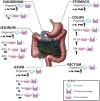Intestinal in vitro and ex vivo Models to Study Host-Microbiome Interactions and Acute Stressors
- PMID: 30483150
- PMCID: PMC6240795
- DOI: 10.3389/fphys.2018.01584
Intestinal in vitro and ex vivo Models to Study Host-Microbiome Interactions and Acute Stressors
Abstract
The gut microbiome is extremely important for maintaining homeostasis with host intestinal epithelial, neuronal, and immune cells and this host-microbe interaction is critical during times of stress or disease. Environmental, nutritional, and cognitive stress are just a few factors known to influence the gut microbiota and are thought to induce microbial dysbiosis. Research on this bidirectional relationship as it pertains to health and disease is extensive and rapidly expanding in both in vivo and in vitro/ex vivo models. However, far less work has been devoted to studying effects of host-microbe interactions on acute stressors and performance, the underlying mechanisms, and the modulatory effects of different stressors on both the host and the microbiome. Additionally, the use of in vitro/ex vivo models to study the gut microbiome and human performance has not been researched extensively nor reviewed. Therefore, this review aims to examine current evidence concerning the current status of in vitro and ex vivo host models, the impact of acute stressors on gut physiology/microbiota as well as potential impacts on human performance and how we can parlay this information for DoD relevance as well as the broader scientific community. Models reviewed include widely utilized intestinal cell models from human and animal models that have been applied in the past for stress or microbiology research as well as ex vivo organ/tissue culture models and new innovative models including organ-on-a-chip and co-culture models.
Keywords: DoD; ex vivo; in vitro; intestine; physiology; stress.
Figures


Similar articles
-
Japanese quail (Coturnix japonica) as a novel model to study the relationship between the avian microbiome and microbial endocrinology-based host-microbe interactions.Microbiome. 2021 Feb 2;9(1):38. doi: 10.1186/s40168-020-00962-2. Microbiome. 2021. PMID: 33531080 Free PMC article.
-
Gut-on-chip for ecological and causal human gut microbiome research.Trends Microbiol. 2022 Aug;30(8):710-721. doi: 10.1016/j.tim.2022.01.014. Epub 2022 Feb 18. Trends Microbiol. 2022. PMID: 35190251 Review.
-
Mechanistic links between gut microbial community dynamics, microbial functions and metabolic health.World J Gastroenterol. 2014 Nov 28;20(44):16498-517. doi: 10.3748/wjg.v20.i44.16498. World J Gastroenterol. 2014. PMID: 25469018 Free PMC article. Review.
-
The Use of Defined Microbial Communities To Model Host-Microbe Interactions in the Human Gut.Microbiol Mol Biol Rev. 2019 Mar 13;83(2):e00054-18. doi: 10.1128/MMBR.00054-18. Print 2019 May 15. Microbiol Mol Biol Rev. 2019. PMID: 30867232 Free PMC article. Review.
-
Total Lipopolysaccharide from the Human Gut Microbiome Silences Toll-Like Receptor Signaling.mSystems. 2017 Nov 14;2(6):e00046-17. doi: 10.1128/mSystems.00046-17. eCollection 2017 Nov-Dec. mSystems. 2017. PMID: 29152585 Free PMC article.
Cited by
-
Reactive oxygen species limit intestinal mucosa-bacteria homeostasis in vitro.Sci Rep. 2021 Dec 9;11(1):23727. doi: 10.1038/s41598-021-02080-x. Sci Rep. 2021. PMID: 34887444 Free PMC article.
-
Studies of xenobiotic-induced gut microbiota dysbiosis: from correlation to mechanisms.Gut Microbes. 2021 Jan-Dec;13(1):1921912. doi: 10.1080/19490976.2021.1921912. Gut Microbes. 2021. PMID: 34313531 Free PMC article. Review.
-
Toward Xeno-Free Differentiation of Human Induced Pluripotent Stem Cell-Derived Small Intestinal Epithelial Cells.Int J Mol Sci. 2022 Jan 24;23(3):1312. doi: 10.3390/ijms23031312. Int J Mol Sci. 2022. PMID: 35163236 Free PMC article.
-
Ex vivo and miniaturized in vitro models to study microbiota-gut-brain axis.3 Biotech. 2024 Nov;14(11):280. doi: 10.1007/s13205-024-04126-z. Epub 2024 Oct 24. 3 Biotech. 2024. PMID: 39464520 Review.
-
Live Biotherapeutic Products, A Road Map for Safety Assessment.Front Med (Lausanne). 2020 Jun 19;7:237. doi: 10.3389/fmed.2020.00237. eCollection 2020. Front Med (Lausanne). 2020. PMID: 32637416 Free PMC article.
References
-
- Allen J. M., Mailing L. J., Cohrs J., Salmonson C., Fryer J. D., Nehra V., et al. . (2017). Exercise training-induced modification of the gut microbiota persists after microbiota colonization and attenuates the response to chemically-induced colitis in gnotobiotic mice. Gut Microbes 9, 115–130. 10.1080/19490976.2017.1372077 - DOI - PMC - PubMed
-
- Anand A. C., Sashindran V. K., Mohan L. (2006). Gastrointestinal problems at high altitude. Trop. Gastroenterol. 27, 147–153. - PubMed
Publication types
Grants and funding
LinkOut - more resources
Full Text Sources
Miscellaneous

